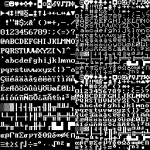Yeah, it's a long shot but I'm looking for dumps of the character ROMs from early IBM display adapters sold outside of the US.
Looking through my old files, I came across a "HEBREW.COM" program dated 6/1983; it also contains the strings "2.0" and "(C) COPYRIGHT IBM ISRAEL LTD. 1983" (so it predates EGA's full "soft font" support, or later DOS commands like GRAFTABL/CHCP). After you load this TSR, hitting Alt+RShift will switch on right-to-left input mode for Hebrew (a rather primitive implementation... it flips the entire screen, and visibly struggles with the BIOS too). Alt+LShift will switch it back off.
If you happen to be in CGA graphics mode, you'll see actual Hebrew characters as you type. The font data (stored within the .COM) is loaded into the upper half of the ASCII table for graphics modes -- this is the extracted bitmap:

Of course, if you're in CGA or MDA text mode, you'll get the hardware ROM font instead. I'm assuming that IBM sold their display adapters with localized character ROMs (as they did elsewhere), and this program relied on such a Hebrew ROM for proper text mode functionality. We used something very similar on our own machine back in the day, but that was just a clone. I'm curious to know whether or not these characters match the contents of IBM's actual ROM.
Long story short: if anyone has access to such a Hebrew character ROM from an IBM card, I'd appreciate a dump. Actually, ROMs from other non-US locales would be nice too.
Thanks!
Looking through my old files, I came across a "HEBREW.COM" program dated 6/1983; it also contains the strings "2.0" and "(C) COPYRIGHT IBM ISRAEL LTD. 1983" (so it predates EGA's full "soft font" support, or later DOS commands like GRAFTABL/CHCP). After you load this TSR, hitting Alt+RShift will switch on right-to-left input mode for Hebrew (a rather primitive implementation... it flips the entire screen, and visibly struggles with the BIOS too). Alt+LShift will switch it back off.
If you happen to be in CGA graphics mode, you'll see actual Hebrew characters as you type. The font data (stored within the .COM) is loaded into the upper half of the ASCII table for graphics modes -- this is the extracted bitmap:

Of course, if you're in CGA or MDA text mode, you'll get the hardware ROM font instead. I'm assuming that IBM sold their display adapters with localized character ROMs (as they did elsewhere), and this program relied on such a Hebrew ROM for proper text mode functionality. We used something very similar on our own machine back in the day, but that was just a clone. I'm curious to know whether or not these characters match the contents of IBM's actual ROM.
Long story short: if anyone has access to such a Hebrew character ROM from an IBM card, I'd appreciate a dump. Actually, ROMs from other non-US locales would be nice too.
Thanks!




